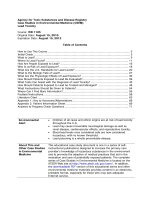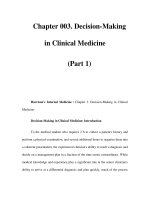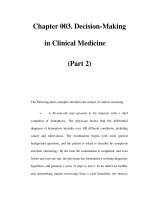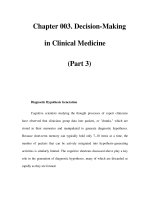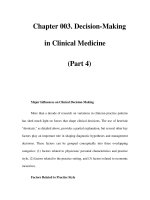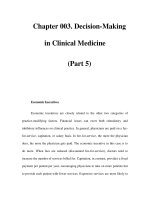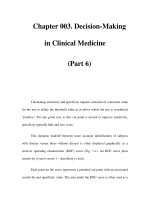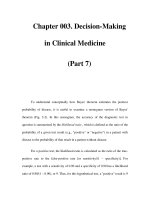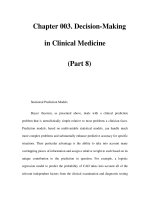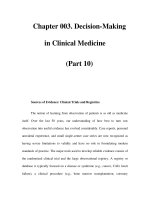100 Case Histories in Clinical Medicine For MRCP by Jypee (PART 1)
Bạn đang xem bản rút gọn của tài liệu. Xem và tải ngay bản đầy đủ của tài liệu tại đây (5.3 MB, 352 trang )
100
CASE HISTORIES
IN CLINICAL MEDICINE
For MRCP (PART 1)
IMPORTANT NOTICE
Medicine is an everchanging science.
Efforts have been made to
include current concepts and therapies.
Readers are therefore
advised to consult
a standard textbook of medicine
for more details.
100
CASE HISTORIES
IN CLINICAL MEDICINE
for MRCP (Part 1)
Farrukh Iqbal
MBBS (Pb), MD (USA), MRCP (UK)
FRCP (Edin), FRCP (London)
Associate Professor of Medicine
Shaikh Zayed Postgraduate Medical Institute
Consultant Physician
Shaikh Zayed Hospital, Lahore
Pakistan
JAYPEE BROTHERS
MEDICAL PUBLISHERS (P) LTD.
New Delhi
Published by
Jitendar P Vij
Jaypee Brothers Medical Publishers (P) Ltd
EMCA House, 23/23B Ansari Road, Daryaganj
New Delhi 110 002, India
Phones: 23272143, 23272703, 23282021, 23245672, 23245683
Fax: 011-23276490
e-mail:
Visit our website:
Branches
• 202 Batavia Chambers, 8 Kumara Kruppa Road
Kumara Park East, Bangalore 560 001, Phones: 2285971, 2382956
Tele Fax: 2281761, e-mail:
• 282 IIIrd Floor, Khaleel Shirazi Estate, Fountain Plaza
Pantheon Road, Chennai 600 008, Phone: 28262665 Fax: 28262331
e-mail:
• 4-2-1067/1-3, Ist Floor, Balaji Building, Ramkote Cross Road
Hyderabad 500 095, Phones: 55610020, 24758498 Fax: 24758499
e-mail:
• 1A Indian Mirror Street, Wellington Square
Kolkata 700 013, Phone: 22451926 Fax: 22456075
e-mail:
• 106 Amit Industrial Estate, 61 Dr SS Rao Road
Near MGM Hospital, Parel, Mumbai 400 012
Phones: 24124863, 24104532 Fax: 24160828
e-mail:
100 Case Histories in Medicine
© 2004, Farrukh Iqbal
All rights reserved. No part of this publication should be reproduced, stored in a
retrieval system, or transmitted in any form or by any means: electronic,
mechanical, photocopying, recording, or otherwise, without the prior written
permission of the author and the publisher.
This book has been published in good faith that the material provided by the
author is original. Every effort is made to ensure accuracy of material, but the
publisher, printer and author will not be held responsible for any inadvertent
error(s). In case of any dispute, all legal matters to be settled under Delhi
jurisdiction only.
First Edition: 2001
Second Edition: 2004
ISBN
81-8061-307-0
Typeset at JPBMP typesetting unit
Printed at Lordson Publishers (P) Ltd., C-5/19, RP Bagh, Delhi 110 007
This book is dedicated
to my
Parents
who taught me
how to read and write
Foreword
I was privileged to be asked to write a foreword to this book published
by a very practical and excellent clinical educator. It was a source
of pride for me as he was my talented pupil with most distinguished
college record and later on a very successful physician. It was a
great pleasure to read the book as it deals with the practical problems
faced in general wards of hospitals in Pakistan.
A manual to be carried in the pocket of every medical student.
Being myself a life-long teaching physician in a clinical setting, I
find this book a good contribution to the subject of clinical medicine
giving a good coverage to different sections of internal medicine.
The presentation is simple, readable, accurate and with a sound
scientific foundation. One feels pleasure and satisfaction after going
through it. This book is an extra help to those doctors who are
preparing for FCPS (Medicine), MRCP (UK) and MD (Medicine)
examinations.
I have no doubt that this book work will receive respect, admiration
and success it rightly deserves from undergraduate, postgraduate
medical students and family practitioners.
Prof M Akhtar Khan
Retired Professor of Medicine
and
Principal, King Edward Medical College
Lahore, Pakistan
Preface
Medical science is a very vast field and is expanding every day. It is
extremely difficult to keep abreast the knowledge, as lots of advancements have been made in this field every moment and the concepts
keep on changing perpetually. However, a medical doctor should at
least be aware of common medical problems which he could face
in his professional career. These problems may present individually
or as multisystem disorders. Basic working knowledge and clinical
skills are required to analyze these problems methodically and reach
to a diagnosis and then plan appropriate management.
This book is an effort to pick up the “brains” by exercising problem
solving. The set up is very simple. A brief history and important
clues on clinical examination along with investigations are provided.
Few important investigations are intentionally omitted and are asked
in questions. In a few histories, the ECG or X-ray is shown and the
reader is expected to interpret those to reach a diagnosis. In this
book SI units have been used.
The lay out is in the form of chapters which are named systemwise and the diagnosis of case histories are labelled as such. If a
reader is interested to read the cases related to, for example,
cardiology, then the reader can go through that chapter and so on.
An attempt has been made to improve important questions related
to the text and current concepts are also discussed. This book will
not only help problem solving in day-to-day life of medical doctors
but will also serve as a purpose for preparing them for their
postgraduate examination in medicine, e.g. FCPS, MRCP and
others.
All these cases were actually recorded and collected by the author
over the last three years and a lot of effort was put in to formulate in
the form of a book. However, in such a small book the information
contained cannot be comprehensive and it may not be a substitute
for a textbook either. Therefore, the candidates should consult one
of the standard textbooks in internal medicine to expand their
knowledge.
The size of this book is such that it can be kept in the pocket so
that the reader, whenever gets time should sit, have a cup of tea,
x 100 Case Histories in Clinical Medicine for MRCP (Part 1)
relax and go through it. I also firmly believe that the clinical skills of
history taking and examination make the main pillar of good medical
practice and most of the cases depend upon clinical presentation
and examination. Although every effort has been made to write this
book in a simple way, but if there are any suggestions for improvement, I would be more than happy to welcome them.
I would like to thank my colleagues for encouraging me to write
this book. I am highly indebted to Dr Asif Kamal FRCP (Lond), FRCP
(Edin), and Dr Avinash Mithal FRCP (Lond), FRCP (Edin), both
Consultant Physicians at Lincoln County Hospitals, UK, for
encouraging me, to write this book and for useful suggestions and
allowing me to follow their footsteps in academics all the time during
my stay in the United Kingdom and even to date. I am grateful to my
wife, Shahina Farrukh, my daughters Saliha and Zunaira and my
son Aizad who extended their full support in writing this book.
The second edition is completely revised after the sale of one
thousand copies in less than one year. In this edition, current
informations on various topics have been included. A conversion
table along with normal values is added in the end of this book.
Lastly I shall welcome constructive and healthy criticisms and
suggestions to improve this book, so that they should be included
in the future editions.
Farrukh Iqbal
Acknowledgements
I am personally thankful to Prof Anwar A Khan (Gastroenterology),
Chairman and Dean of Shaikh Zayed Postgraduate Medical Institute
Prof Abdul Hayee (Haematology), Prof Muhammad Asim Khan from
the USA (Rheumatology), Prof Saulat Siddique (Cardiology), Dr
Nazim H Bokhari (Pulmonology) and Dr Nadir Zafar Khan
(Neurology) all from Shaikh Zayed Postgraduate Medical Institute,
Lahore for reading the relative chapters of the script and giving
their valuable suggestions. I am also grateful to Prof Tahir Shafi,
Professor of Nephrology and Ex-Chairman and Dean of Shaikh
Zayed Postgraduate Medical Institute for being very kind and
affectionate and of course to Prof Zafar Iqbal, Professor of Medicine
for his encouragement and co-operation in writing this book. It would
not be fair if I do not mention about a number of my students who
actually made this book practically possible by continuously
hammering me to get it published. I am indebted to Mr M Shahzad
Mughal from the Institute of Education and Research, University of
the Punjab for composing the manuscript. I am also thankful to all
my other colleagues who have helped me in all ways.
Contents
PART ONE
Case
Case
Case
Case
Case
Case
Case
1
2
3
4
5
6
7
Rheumatic Heart Disease ......................................... 1
Left Atrial Myxoma ..................................................... 4
Infective Endocarditis ................................................. 7
WPW Syndrome ...................................................... 10
Acute Pericarditis ..................................................... 13
Inferior Myocardial Infarction .................................... 17
Left Ventricular Aneurysm ........................................ 22
PART TWO
Case
Case
Case
Case
Case
Case
Case
Case
Case
Case
8
9
10
11
12
13
14
15
16
17
18
19
20
21
22
23
24
25
26
27
28
29
PULMONOLOGY
Pulmonary Embolism .............................................. 25
Empyema ................................................................ 29
Pulmonary Tuberculosis ........................................... 32
Atypical Pneumonia ................................................. 35
Pleural Effusion ....................................................... 38
Lobar Pneumonia .................................................... 41
Bronchiectasis ......................................................... 44
Lung Abscess .......................................................... 48
Bronchogenic Carcinoma ........................................ 51
Cor pulmonale ......................................................... 54
PART THREE
Case
Case
Case
Case
Case
Case
Case
Case
Case
Case
Case
Case
CARDIOLOGY
GASTROENTEROLOGY
Cholangitis............................................................... 57
Oesophageal Varices ............................................... 60
Amoebic Liver Abscess ........................................... 64
Malabsorption .......................................................... 67
Hepatic Encephalopathy .......................................... 71
Constipation ............................................................ 75
Intestinal Obstruction ............................................... 78
Mesenteric Infarction ............................................... 81
Ulcerative Colitis ...................................................... 84
Acute Pancreatitis .................................................... 90
Carcinoma Colon ..................................................... 94
Peptic Ulcer ............................................................. 97
xiv 100 Case Histories in Clinical Medicine for MRCP (Part 1)
Case 30 Primary Biliary Cirrhosis ........................................ 100
Case 31 Carcinoma Oesophagus ........................................ 103
Case 32 Chronic Hepatitis/Cirrhosis .................................... 106
PART FOUR
Case
Case
Case
Case
Case
Case
Case
Case
Case
Case
Case
Case
Case
33
34
35
36
37
38
39
40
41
42
43
44
45
Meningitis .............................................................. 109
Parkinsonism ......................................................... 112
CVA ....................................................................... 115
Shy-Drager Syndrome ........................................... 118
Brain Tumour ......................................................... 121
Viral Encephalitis ................................................... 124
Motor Neuron Disease .......................................... 127
Moyamoya Disease ............................................... 130
Acoustic Neuroma ................................................. 133
Multiple Sclerosis .................................................. 136
Pseudotumour Cerebri .......................................... 140
Wilson’s Disease ................................................... 143
Sub-arachnoid Haemorrhage ................................ 146
PART FIVE
Case
Case
Case
Case
46
47
48
49
50
51
52
53
54
55
56
HAEMATOLOGY
Idiopathic Thrombocytopaenic Purpura ................. 163
Myelofibrosis ......................................................... 167
Polycythaemia ....................................................... 171
Pernicious Anaemia / SACDC ............................... 174
von Willebrand’s Disease ....................................... 178
Multiple Myeloma ................................................... 181
Chronic Myeloid Leukaemia .................................. 185
PART SEVEN
Case
Case
Case
Case
57
58
59
60
MUSCULOSKELETAL
Myasthenia Gravis ................................................. 159
Paget’s Disease ..................................................... 152
Polymyositis ........................................................... 156
Osteoporosis ......................................................... 159
PART SIX
Case
Case
Case
Case
Case
Case
Case
NEUROLOGY
ENDOCRINOLOGY
Addison’s Disease ................................................. 188
Hyperparathyroidism ............................................. 191
Diabetic Retinopathy ............................................. 194
Turner’s Syndrome ................................................ 197
Contents xv
Case
Case
Case
Case
Case
Case
Case
Case
Case
61
62
63
64
65
66
67
68
69
Acromegaly ........................................................... 201
Klinefelter’s Syndrome ........................................... 205
Conn’s Syndrome .................................................. 208
Hypothyroidism ...................................................... 211
Cushing’s Syndrome ............................................. 214
Hyperthyroidism .................................................... 218
Pheochromocytoma .............................................. 221
Diabetic Amyotrophy.............................................. 224
S-I-A-D-H Syndrome ............................................. 227
PART EIGHT
Case
Case
Case
Case
70
71
72
73
Renal Tubular Acidosis .......................................... 230
Carcinoma Prostate ............................................... 233
Acute Pyelonephritis .............................................. 236
Polycystic Kidneys ................................................. 239
PART NINE
Case
Case
Case
Case
Case
Case
74
75
76
77
78
79
80
81
82
83
84
85
86
87
88
89
90
INFECTIOUS DISEASES
Scabies ................................................................. 265
Infectious Mononucleosis ...................................... 268
Enteric Fever ......................................................... 271
AIDS ...................................................................... 275
Malaria .................................................................. 279
Herpes Zoster ....................................................... 283
Measles ................................................................. 286
PART ELEVEN
Case
Case
Case
Case
RHEUMATOLOGY
Rheumatoid Arthritis .............................................. 242
Temporal Arteritis .................................................. 246
Polyarteritis Nodosa .............................................. 250
Gout ...................................................................... 254
Ankylosing Spondylitis ........................................... 257
Systemic Lupus Erythematosus ............................ 261
PART TEN
Case
Case
Case
Case
Case
Case
Case
NEPHROLOGY
DRUG TOXICITY
Digoxin Toxicity ...................................................... 290
Phenytoin Toxicity .................................................. 293
Levodopa Toxicity .................................................. 296
Paracetamol Toxicity .............................................. 299
xvi 100 Case Histories in Clinical Medicine for MRCP (Part 1)
PART TWELVE
Case
Case
Case
Case
Case
Case
Case
Case
Case
Case
MISCELLANEOUS
91 Hypothermia .......................................................... 302
92 Porphyria ............................................................... 305
93 Toxic Shock Syndrome .......................................... 309
94 Goodpasture’s Syndrome ...................................... 312
95 Milroy’s Disease .................................................... 315
96 Falls ....................................................................... 318
97 Scurvy ................................................................... 321
98 Carcinoid Syndrome .............................................. 324
99 Ochronosis ............................................................ 327
100 Malignant Melanoma ............................................. 330
Conversion Table ............................................................ 333
Index .............................................................................. 335
1
C
A
S
E
Cardiology
Rheumatic Heart Disease
BRIEF HISTORY
An 18-year-old girl was admitted through out-patient department
with six hours history of severe left sided chest pain. For the last
four months, she had increasing shortness of breath and fatigue on
exertion with swelling of her ankles. During the last four hours of
her chest pain, her breathlessness had worsened. There was no
history of haemoptysis. She had mild unproductive cough for the
last three months. The chest pain was described as sharp with no
radiation and was worse on deep breathing. She had been given
frusemide 40 mg daily for her swollen legs and had also been started
on digoxin 0.25 mg once a day a week before her admission. Her
doctor had given her pethidine 50 mg parenterally before sending
her to the hospital, but this had failed to control her pain. She had
no known drug allergies. She could remember having frequent sore
throats as a child, but there was no clear history of joint pains. One
of her brothers, however, had a heart condition and had been treated
with medicines for a long time.
IMPORTANT CLUES ON CLINICAL EXAMINATION
On examination, she was very dyspnoeic and had central cyanosis.
She was apyrexial. JVP was raised by 4 cm. There was moderate
pitting oedema over her both legs. Her throat was normal. Blood
pressure was 120/70 mm Hg. There was no clubbing or
lymphadenopathy. Clinically she was euthyroid. Her pulse was
110 per minute and irregularly irregular. Peripheral pulses were
palpable. Apex beat was tapping in character and she had a left
parasternal heave. The first heart sound was loud and she had a
rough, rumbling, mid-diastolic murmur localized to the apex.
2 Cardiology
Opening snap followed closely on the second heart sound. She had
bilateral basal crackles with dullness and diminished air entry at
her left base. There was no pleural rub. Liver was 4 cm enlarged,
smooth and tender. There was no splenomegaly or ascites. Fundi
were normal and there were no localizing neurological signs.
INVESTIGATIONS
The following results of the initial investigations were available:
Hb:
WCC:
Platelets :
ESR:
Sodium:
Potassium :
Bicarbonate:
Chloride:
12.8 g/dl
(normocytic
normochromic)
9.2 × 109/l
P:76% L:20%
M:2%E:2%
310 × 109/l
60 mm in
1st hour
134 mmol/l
3.6 mmol/l
24 mmol/l
99 mmol/l
Blood sugar
Blood urea
Creatinine:
Urine:
ECG:
6.6 mmol/l (118 mg/dl)
6.8 mmol/l (41 mg/dl)
110 umol/l (1.2 mg/dl)
trace of protein
confirmed atrial
fibrillation,there
were no
ischaemic changes.
QUESTIONS
Q.1. What is the most likely diagnosis and what complication
has occurred?
Q.2. What further four investigations will help the diagnosis?
Q.3. Give six important steps in the management of this patient.
Q.4. What criteria is applied to this disease?
Rheumatic Heart Disease
3
ANSWERS
A.1. The most likely diagnosis in this young girl with four
months history of increasing fatigue, shortness of breath,
swelling of ankles with previous history of repeated sore
throats and characteristic findings of mitral stenosis,is
rheumatic heart disease. Sudden sharp pleuritic chest pain
in a girl with mitral stenosis and atrial fibrillation strongly
supports the diagnosis of pulmonary embolism. Systemic
or pulmonary embolism is a common complication of atrial
fibrillation. A pleural rub is not always present and may
sometimes be difficult to detect in the presence of diffuse
crackles and/or effusion.
A.2. i. Chest X-ray
ii. Ventilation-perfusion (V/Q) scan
iii. Echocardiography
iv. Pulmonary angiography.
A.3. i.
ii.
iii.
iv.
v.
Oxygen inhalation.
Anti-coagulation (start with heparin).
Control of pain. Strong analgesics.
Digoxin to control atrial fibrillation.
Diuretics preferably given parenterally to dry up the
lungs.
vi. Consider using thrombolytic therapy (streptokinase).
A.4. This includes major and minor criteria called Duckitt Jone’s
criteria.
The major criteria:
i. Carditis
ii. Polyarthritis
iii. Chorea (Sydenham’s)
iv. Erythema marginatum
v. Subcutaneous nodules.
The minor criteria:
i. Fever.
ii. Arthralgia.
iii. Raised ESR or positive C-reactive protein in high titres.
iv. Prolonged P-R interval on ECG.
Two major and one minor or one major and two minor
criteria are required to diagnose rheumatic fever.
2
Infectious Diseases
C
A
S
E
Left Atrial Myxoma
BRIEF HISTORY
A 35-year-old man presented to the cardiology outpatient with a
history of fever, malaise and palpitations for the last four months.
The fever was low grade and intermittent in character. On one
occasion, he developed sudden pain in the left leg which became
pale, cold and heavy. Two weeks prior to his recent visit to the
hospital, he had a syncopal attack and recovered spontaneously.
There was no history of chest pain but occasionally he had dyspnoea
on exertion.
IMPORTANT CLUES ON CLINICAL EXAMINATION
On examination, he looked pale and a bit anxious. Temperature
was 99.4°F. General physical examination was normal. Pulse was
96 per min, regular and good volume with all peripheral pulses
palpable. BP was 130/85 mm Hg. First heart sound was split with
accentuation of the pulmonic component of second heart sound
and mid-diastolic murmur at mitral area. Chest examination
revealed bilateral basal crackles. Abdominal and neurological
systems were normal.
INVESTIGATIONS
Investigations included:
Hb:
WCC:
9.8 g/dl
(normocytic
normochromic)
8.8 × 109/ l
P:76% L:20%
M:2%E:2%
Blood sugar:
Blood urea:
Creatinine:
Urine:
ECG:
4.4 mmol/l (79 mg/dl)
8 mmol/l (48 mg/dl)
108 umol/l (1.2 mg/dl)
normal
sinus rhythm, no
ischaemic changes
Contd...
Left Atrial Myxoma
5
Contd...
310 × 109/l
95 mm in
1st hour
Sodium
138 mmol/l
Potassium: 4.2 mmol/l
Bicarbonate: 26 mmol/l
Chloride:
99 mmol/l
Platelets:
ESR:
Chest X-ray:
straightening of left
border of heart which
was normal in size.
QUESTIONS
Q.1. What is the diagnosis?
Q.2. What further investigations would you ask for?
Q.3. What happens to the immuno-electrophoretic pattern in
this condition?
Q.4. Give a brief account about this condition.
Q.5. What is the treatment?
6 Cardiology
ANSWERS
A.1. In a person who had history of low grade fever, weight
loss, occlusion of an artery (left lower limb), a syncopal
attack and raised ESR point towards a diagnosis of left atrial
myxoma. Presence of murmur makes it more probable.
A.2. Echocardiogram is characteristic in this case. There is
persistent uniform echogenicity behind the anterior mitral
valve leaflet if the myxoma is protruding in the mitral valve
area on M-mode while on two-dimensional view, the
myxoma is visible in the left atrium.
A.3. There is increase in IgG fraction of gamma globulins.
A.4. Although these are rare primary tumours of the heart, but
they are potentially curable. They occur most frequently
in the atria, and left atrium is involved three times more
than the right atrium. They may be unilateral or bilateral
and are often pedunculated, while if they are present in
the ventricles, they are sessile. The symptoms result from
impediment to blood flow through the heart, embolization
from the tumour in the systemic or pulmonary beds and
generalised constitutional abnormalities. Left atrial
myxomas mimic mitral stenosis or regurgitation and their
sequelae, while right atrial myxoma presents as tricuspid
stenosis.
A.5. It is surgical resection of the tumour which results in
complete cure, including relief of the constitutional
symptoms. Because of the potential for recurrence, the
endocardial attachment should be excised. Follow-up
echocardiography is required afterwards.
3
Infectious Diseases
C
A
S
E
Infective Endocarditis
BRIEF HISTORY
A 60-year-old woman was admitted through the outpatient clinic
with a four-month history of weight loss, loss of appetite and fever
with rigors and night sweats. She also complained of increased
breathlessness and tiny reddish lesions on the palms and pulp of
the fingers which were painful. She also had some dragging
sensation in the left hypochondrium. In the past, she was operated
for mitral valve stenosis by valvotomy. She was a known
hypertensive and diabetic.
IMPORTANT CLUES ON CLINICAL EXAMINATION
On examination, she looked pale and had a temperature of 100°F.
She was clubbed and there were a few streaks in her nails. Pulse
was 108 per minute regular, and all the pulses were palpable. Heart
sounds were normal, but there was a pan-systolic murmur at mitral
area which radiated towards left axilla. Chest was clear but
abdominal examination revealed splenomegaly. Neurological
examination was normal.
INVESTIGATIONS
Investigations included:
Hb:
8.4 g/dl
(normocytic
normochromic)
Urine:
WBC:
16.6 × 109/l
P:71% L:21%
M:5% E:3%
Chest X-ray:
traces of albumin
and a few
RBCs per high
power field seen.
mitralization of the
left border of heart
with prominent
Contd...
8 Cardiology
Contd...
ESR:
Sodium:
Potassium:
Bicarbonate:
Chloride:
95 mm in 1st hour
140 mmol/l
4.3 mmol/l
25 mmol/l
110 mmol/l
pulmonary blood
vessels.
QUESTIONS
Q.1.
Q.2.
Q.3.
Q.4.
Q.5.
Q.6.
What is the diagnosis?
What further investigations would you ask for?
What possible organisms are involved?
What do you know in reference to Libman Sacks?
What are the vasculitic lesions of this disorder?
What is the treatment?
Infective Endocarditis 9
ANSWERS
A.1. The history, examination and investigations lead to a
diagnosis of infective endocarditis.
A.2. i. Blood cultures: At least four to six sets of blood culture
are required, but one should be aware of special media
for other organisms. At least 5 to 10 ml of blood should
be withdrawn for each example.
ii. Echocardiogram: To see any vegetations on the mitral
valve.
A.3. i. Streptcoccus viridans
vii. Brucella
ii. Streptococcus faecalis
viii. Listeria
iii. Staphylococcus aureus
ix. Candida
iv. Pneumococcus
x. Aspergillus
v. Gonococcus
xi. Coliform bacteria
vi. Histoplasma
xii. Coxiella burnetti
A.4. These are non-infective vegetations which occur in systemic
lupus erythematosis called Libman-Sacks endocarditis.
A.5. The vasculitic lesions include, Oslers nodes, which are
tender subcutaneous nodules and are purplish or reddish.
They classically occur on finger pulps. Janeways lesions
are large, erythematous, painful and tender maculopapular lesions which may develop on the palms or soles.
Roths spots are small, flame-shaped haemorrhages which
are found in the retina and may also have a pale centre.
A.6. Mostly it is streptococcus viridans and, therefore benzyl
penicillin is the treatment of choice which is supplemented
with gentamycin for synergistic effect. The former should
be given parenterally for four weeks, while the latter can
be given for the first two weeks. Pencillinase resistant
penicillin analogues should be used in cases due to
penicillin-resistant organisms, e.g. methicillin, oxacillin,
nafcillin, cephalosporins, etc. In patients who are allergic
to penicillin, erythromycin, cephalosporins and vancomycin are alternative drugs.
Fungal infections are treated with amphotericin B therapy.
If bacterial endocarditis develops more than six weeks after
the cessation of treatment, it usually is a new infection.
